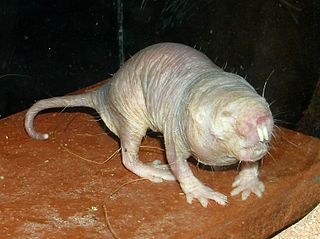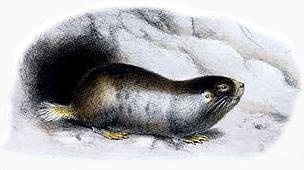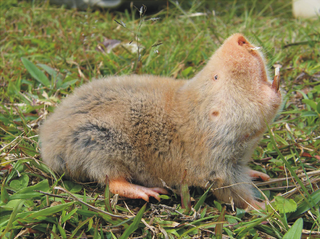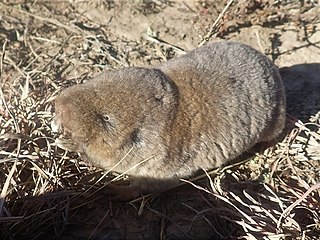Mole-rat or mole rat can refer to several groups of burrowing Old World rodents:

The rodent subfamily Rhizomyinae includes the Asian bamboo rats and certain of the African mole-rats. The subfamily is grouped with the Spalacinae and the Myospalacinae into a family of fossorial muroid rodents basal to the other Muroidea.

The naked mole-rat, also known as the sand puppy, is a burrowing rodent native to the Horn of Africa and parts of Kenya, notably in Somali regions. It is closely related to the blesmols and is the only species in the genus Heterocephalus.

The Spalacidae, or spalacids, are a family of rodents in the large and complex superfamily Muroidea. They are native to eastern Asia, the Horn of Africa, the Middle East, and southeastern Europe. It includes the blind mole-rats, bamboo rats, mole-rats, and zokors. This family represents the oldest split in the muroid superfamily, and comprises animals adapted to a subterranean way of life. These rodents were thought to have evolved adaptations to living underground independently until recent genetic studies demonstrated they form a monophyletic group. Members of the Spalacidae are often placed in the family Muridae along with all other members of the Muroidea.

The blind mole-rats, also known as the fossorial or subterranean mole rats, are a subfamily (Spalacinae) of rodents in the family Spalacidae, found in eastern Europe and western & central Asia. The hystricognath mole-rats of the family Bathyergidae are completely unrelated, but some other forms are also in the family Spalacidae. Zokors, root rats, and bamboo rats are spalacids also sometimes referred to as mole rats.

The blesmols, also known as mole-rats, or African mole-rats, are burrowing rodents of the family Bathyergidae. They represent a distinct evolution of a subterranean life among rodents much like the pocket gophers of North America, the tuco-tucos in South America, or the Spalacidae from Eurasia.

The rodent parvorder or infraorder Phiomorpha comprises several living and extinct families found wholly or largely in Africa. Along with Anomaluromorpha and perhaps the extinct Zegdoumyidae, it represents one of the few early colonizations of Africa by rodents.

The Damaraland mole-rat, Damara mole rat or Damaraland blesmol, is a burrowing rodent found in southern Africa. Along with the smaller, less hairy, naked mole rat, it is a species of eusocial mammal.

Bathyergus is the genus of dune mole-rats endemic to South Africa. It contains two species — B. janetta, the Namaqua dune mole-rat, and B. suillus, the Cape dune mole-rat.

The Cape mole-rat is a species of mole-rat endemic to South Africa. It is the only extant species currently described as belonging to the genus Georychus.

The silvery mole-rat, silvery blesmol, or silky mole-rat is a species of mole-rat of East Africa which occurs in southern Kenya, Tanzania, southeastern Democratic Republic of Congo, Mozambique and Malawi. Solitary and aggressive, little is known about its ecology or behavior. It is monotypic in the genus Heliophobius. A common species, the International Union for Conservation of Nature has rated it as being of "least concern".

The Namaqua dune mole-rat is a species of rodent in the family Bathyergidae found in Namibia and South Africa. Its natural habitats are subtropical or tropical dry shrubland, caves, and sandy shores.
The Nigerian mole-rat is a species of rodent in the family Bathyergidae. It is found in northern Nigeria and Cameroon. A colonial, subterranean species, its natural habitats are tropical dry lowland grassland, riverside woodland and rocky places.

Mechow's mole-rat is a species of rodent in the family Bathyergidae. It is found in Angola, Democratic Republic of the Congo, Zambia, and possibly Malawi. Its natural habitats are moist savanna, subtropical or tropical dry shrubland, and subtropical or tropical dry lowland grassland. This mole-rat was first described by the German naturalist Wilhelm Peters in 1881. The specific epithet honours the Prussian explorer and naturalist Friedrich Wilhelm Alexander von Mechow.
The Ghana mole-rat or Togo mole-rat is a species of rodent in the family Bathyergidae. It is endemic to Ghana.

The northeast African mole-rat is a species of rodent in the family Spalacidae and is found in Ethiopia, Somalia, and northwest Kenya. Its natural habitats are subtropical or tropical moist montane forests, dry savanna, high-altitude shrubland and grassland. It lives a solitary existence underground and produces a small litter of pups twice a year, in the two rainy seasons. Some taxonomic authorities lump this species, along with a number of others in the genus, in which case the English name East African mole-rat is used.

Rodents are mammals of the order Rodentia, which are characterized by a single pair of continuously growing incisors in each of the upper and lower jaws. About 40% of all mammal species are rodents. They are native to all major land masses except for New Zealand, Antarctica, and several oceanic islands, though they have subsequently been introduced to most of these land masses by human activity.

The common mole-rat, African mole-rat, or Hottentot mole-rat, is a burrowing rodent found in Southern Africa, in particular in the Western Cape province of South Africa. It also occurs in Eswatini, Lesotho, Malawi, Mozambique, Tanzania, Zambia, and Zimbabwe. It is a species in the subfamily Bathyerginae.

Fukomys is a genus described in 2006 of common mole-rats, containing several species that were formerly placed in the genus Cryptomys; its species are endemic to Africa.















